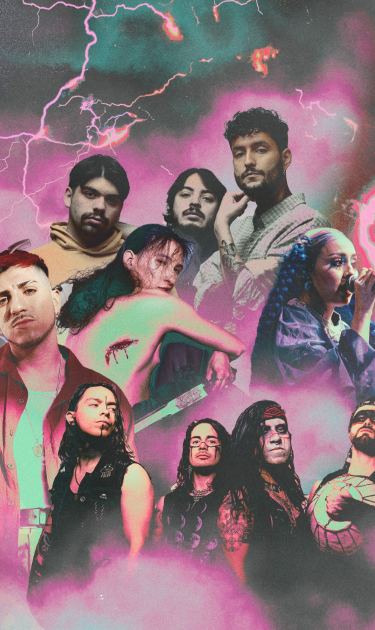The Mess is a new column from journalist Richard Villegas, who has been reporting on new, exciting sounds flourishing in the Latin American underground for nearly a decade. As the host of the Songmess Podcast, his travels have intersected with fresh sounds, scene legends, ancestral traditions, and the socio-political contexts that influence your favorite artists. The Mess is about new trends and problematic faves whilst asking hard questions and shaking the table.
We’re going there. We’re talking about it. Even if things get a little messy.
Back in December, I was traveling around Chile as part of renowned music industry markets Fluvial and Pulsar, where, as is the point, I discovered a ton of incredible music. I’m always excited to share new artists on my radar, and as I was speaking about my findings with a colleague in Argentina, he responded, “Chile? Nah man, call me when they start making pop again.” Before you open the floodgates of Argentina hateration, let me tell you this isn’t the first time I’ve heard such a rebuttal. In fact, this is a position I, too, held until recently, not only as an obsessive fan of Chile’s indie pop golden age but also as a music writer who made his name documenting the beloved scene on this very site. However, since the back-to-back onslaught of El Estallido Social and the pandemic, the sounds pouring out of the Andean nation capture a brave new musical world, and it’s time we put our nostalgia aside and rejoin them in the present.
First, let’s wind back the clock to 2006, when Javiera Mena’s synthy singer-songwriter debut, Esquemas Juveniles, kicked off Chile’s blog-darling reputation, followed by classics from Gepe, Dënver, Alex Anwandter, Fakuta, Adrianigual, Astro, and Marineros. This was a generation of artists born at the end of Pinochet’s brutal dictatorship, and by the late aughts, they experienced freedom and economic growth their parents never had. They studied classic dance music records and the intersection of social discourse and stadium pop on Los Prisioneros’ Corazones, influencing the Latin American underground over the next decade. As the age of naive pop petered out, Neoperreo queen Tomasa del Real ushered the rise of digital reggaeton, while indie rock resurged under the fuzzy melancholy of Niños del Cerro and Playa Gótica.

Eras come and go and they’re more clearly studied in hindsight, but that’s not to say Chile became an inert moon — quite the opposite. Last year, reggaeton chileno became the top Latine sub-genre on Spotify U.S. thanks to FloyyMenor and Cris MJ’s smash hit “Gata Only,” which even landed on President Barack Obama’s end-of-year playlist. Before we all became locas and locotrones, Chilean perreo stars Polimá Westcoast, Paloma Mami, and Julianno Sosa also courted the mainstream with viral bangers. Since the pandemic, Chile’s ebullient trap scene earned trailblazers Pablo Chill-E, Kiddtetoon, and Diego Smith blockbuster collaborations with Bad Bunny and Ozuna. So we’re not just talking about fluctuating trends and industry projections anymore, but a zeitgeist of kids raised under social media, streaming, impending climate calamity, and growing class disparity who are redefining the language and direction of music.
“I’m of the Internet generation, and when I was 16, a bunch of kids at school rapped and listened to trap, and they taught me how to record myself,” remembers the 22-year chameleon Kuina, whose new EP konjuro is stacked with reggaeton, R&B, and jersey club. “I used to make pop that sounded like Clairo, and I got into [el movimiento] when I started listening to Polimá. But people listen to reggaeton differently now. It used to only be for parties, and then Kidd Voodoo started exploring a more sentimental side that opened doors for alternative sounds.”
“Distortion and intensity are back in a big way,” offers Benjamín de la Fuente, lead singer of emo revival band Estoy Bien. The trio behind 2023’s acclaimed Apoyo Emocional LP soared as part of a scene of rabid hardcore and grunge bands, including Candelabro, Asia Menor, Confío en Tus Amigos, and Déjenme Dormir, revitalizing the Chilean rock spectrum and transforming mosh pits into group therapy. “The pandemic had a lot to do with it,” adds Estoy Bien’s drummer, Alberto Pino. “We were all so isolated that once we were together again, all we wanted was to jump and mosh and scream our favorite songs.”

The rage fueling these bands is linked to unresolved trauma left over from El Estallido Social, where all efforts to pass a new constitution were defeated at the polls, and officials who violated countless human rights enjoyed overwhelming impunity. Well, with one notable exception. Lost in the fog of uncertainty, many artists began studying and questioning the meaning of their chilenidad to fascinating results. Down in the southern city of Chillán, Phuyu y La Fantasma rage about neoliberalism and privatized public resources on dazzling albums melding hardcore and post-rock with traditional cuecas and décimas. Concepción-based singer-songwriter Javiera Electra is putting a theatrical spin on cueca and tonada, infusing visceral pieces about precarity and transformation with avant-garde prog-rock. Meanwhile, Mapuche metal band Mawiza is rejecting colonial paradigms with thrashing epics sung in native Mapuzungun, exulting the ancestral and environmental wisdom of a territory unbound by imaginary borders.
In an increasingly globalized and hegemonic world, it’s disruptive to appropriate your own culture.
“Playing with tradition can be very touchy, and some people criticize us because they want cueca to live in a museum,” says rapper Martín Acertijo, one of the founders of the Corte Chilenero movement. Drawing from waves like cueca brava and corridos tumbados, this thriving scene is weaving rhythmic and songwriting patterns from Chile’s vast folk canon with the swagger and grit of trap, drill, and reggaeton. Joining forces with peers including Los Puntuos, Feis6, Entremares, and A Los 4 Vientos, this growing collective of artists is writing a new chapter for Chilean music while updating homegrown idiosyncrasies.
“[In the 2010s], the social pendulum swung towards the left. And now, after El Estallido, everything is going towards the right,” reflects Acertijo. “Corte chilenero engages with our times because it’s guided by identity. We’ve appropriated symbols like the flag, which sometimes makes people feel uncomfortable. But for us, it’s conciliatory. In an increasingly globalized and hegemonic world, it’s disruptive to appropriate your own culture.”

I can understand why fans of the sunny indie pop scene of the 2010s have a hard time embracing hyper-mainstream reggaeton, raging punk, and traditionalist experiments. The music is now darker, angrier, and weirder, but so is the world, and so are we. Chile is no longer synonymous with pop escapism, though I suppose that comfort still exists in the recesses of our memory and meticulously curated playlists. But that’s not where I choose to live. Too many Chileans stormed the streets demanding change for me to linger in a past they desperately wished to leave behind. The least I can do is meet them in the mosh pit.




